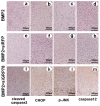Different Roles of GRP78 on Cell Proliferation and Apoptosis in Cartilage Development
- PMID: 26370957
- PMCID: PMC4613247
- DOI: 10.3390/ijms160921153
Different Roles of GRP78 on Cell Proliferation and Apoptosis in Cartilage Development
Abstract
Eukaryotic cells possess several mechanisms to adapt to endoplasmic reticulum (ER) stress and thereby survive. ER stress activates a set of signaling pathways collectively termed as the unfolded protein response (UPR). We previously reported that Bone morphogenetic protein 2 (BMP2) mediates mild ER stress and activates UPR signal molecules in chondrogenesis. The mammalian UPR protects the cell against the stress of misfolded proteins in the endoplasmic reticulum. Failure to adapt to ER stress causes the UPR to trigger apoptosis. Glucose regulated protein 78 (GRP78), as an important molecular chaperone in UPR signaling pathways, is responsible for binding to misfolded or unfolded protein during ER stress. However the influence on GRP78 in BMP2-induced chondrocyte differentiation has not yet been elucidated and the molecular mechanism underlyng these processes remain unexplored. Herein we demonstrate that overexpression of GRP78 enhanced cell proliferation in chondrocyte development with G1 phase advance, S phase increasing and G2-M phase transition. Furthermore, overexpression of GRP78 inhibited ER stress-mediated apoptosis and then reduced apoptosis in chondrogenesis induced by BMP2, as assayed by cleaved caspase3, caspase12, C/EBP homologous protein (CHOP/DDIT3/GADD153), p-JNK (phosphorylated c-Jun N-terminal kinase) expression during the course of chondrocyte differentiation by Western blot. In addition, flow cytometry (FCM) assay, terminal deoxynucleotidyl transferase-mediated deoxyuridine triphosphate-biotin nick end-labeling (TUNEL) assay and immune-histochemistry analysis also proved this result in vitro and in vivo. It was demonstrated that GRP78 knockdown via siRNA activated the ER stress-specific caspase cascade in developing chondrocyte tissue. Collectively, these findings reveal a novel critical role of GRP78 in regulating ER stress-mediated apoptosis in cartilage development and the molecular mechanisms involved.
Keywords: ER stress; GRP78; apoptosis; cartilage development; unfolded protein response.
Figures









Similar articles
-
IRE1α dissociates with BiP and inhibits ER stress-mediated apoptosis in cartilage development.Cell Signal. 2013 Nov;25(11):2136-46. doi: 10.1016/j.cellsig.2013.06.011. Epub 2013 Jun 29. Cell Signal. 2013. PMID: 23816533
-
Explore on the effect of ATF6 on cell growth and apoptosis in cartilage development.Histochem Cell Biol. 2014 Nov;142(5):497-509. doi: 10.1007/s00418-014-1233-y. Epub 2014 Jun 17. Histochem Cell Biol. 2014. Retraction in: Histochem Cell Biol. 2020 Aug;154(2):245. doi: 10.1007/s00418-020-01907-4. PMID: 24934104 Retracted.
-
Regulation of chondrocyte differentiation by IRE1α depends on its enzymatic activity.Cell Signal. 2014 Sep;26(9):1998-2007. doi: 10.1016/j.cellsig.2014.05.008. Epub 2014 May 23. Cell Signal. 2014. PMID: 24863879
-
Molecular signal networks and regulating mechanisms of the unfolded protein response.J Zhejiang Univ Sci B. 2017 Jan.;18(1):1-14. doi: 10.1631/jzus.B1600043. J Zhejiang Univ Sci B. 2017. PMID: 28070992 Free PMC article. Review.
-
IRE1 signaling regulates chondrocyte apoptosis and death fate in the osteoarthritis.J Cell Physiol. 2022 Jan;237(1):118-127. doi: 10.1002/jcp.30537. Epub 2021 Jul 23. J Cell Physiol. 2022. PMID: 34297411 Free PMC article. Review.
Cited by
-
Mesencephalic astrocyte-derived neurotropic factor is an important factor in chondrocyte ER homeostasis.Cell Stress Chaperones. 2019 Jan;24(1):159-173. doi: 10.1007/s12192-018-0953-7. Epub 2018 Dec 12. Cell Stress Chaperones. 2019. PMID: 30543055 Free PMC article.
-
Quercetin and aconitine synergistically induces the human cervical carcinoma HeLa cell apoptosis via endoplasmic reticulum (ER) stress pathway.PLoS One. 2018 Jan 11;13(1):e0191062. doi: 10.1371/journal.pone.0191062. eCollection 2018. PLoS One. 2018. PMID: 29324796 Free PMC article.
-
The Roles of Unfolded Protein Response Pathways in Chlamydia Pathogenesis.J Infect Dis. 2017 Feb 1;215(3):456-465. doi: 10.1093/infdis/jiw569. J Infect Dis. 2017. PMID: 27932618 Free PMC article.
-
Potential to Eradicate Cancer Stemness by Targeting Cell Surface GRP78.Biomolecules. 2022 Jul 5;12(7):941. doi: 10.3390/biom12070941. Biomolecules. 2022. PMID: 35883497 Free PMC article. Review.
-
Tang-Luo-Ning, a Traditional Chinese Medicine, Inhibits Endoplasmic Reticulum Stress-Induced Apoptosis of Schwann Cells under High Glucose Environment.Evid Based Complement Alternat Med. 2017;2017:5193548. doi: 10.1155/2017/5193548. Epub 2017 Nov 21. Evid Based Complement Alternat Med. 2017. PMID: 29362588 Free PMC article.
References
Publication types
MeSH terms
Substances
LinkOut - more resources
Full Text Sources
Other Literature Sources
Molecular Biology Databases
Research Materials
Miscellaneous

